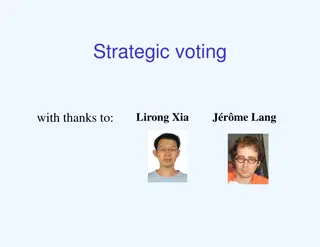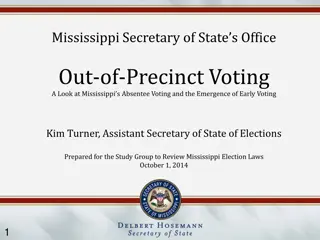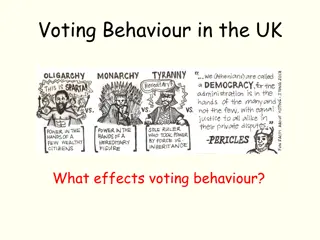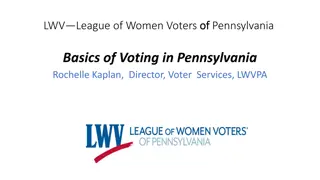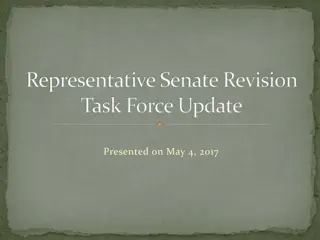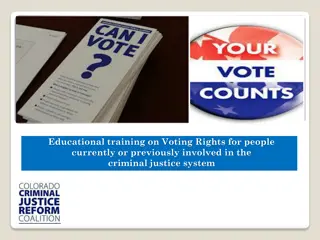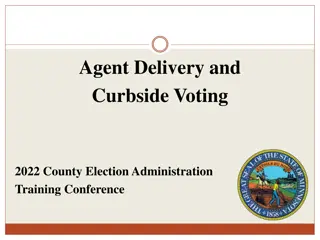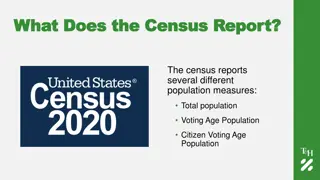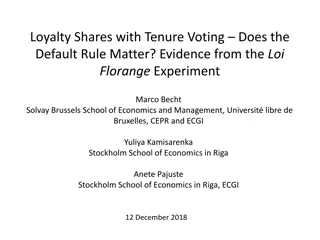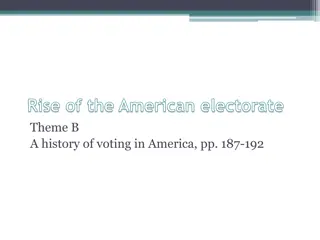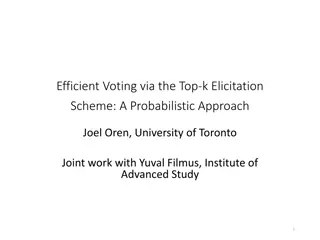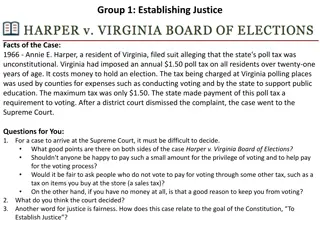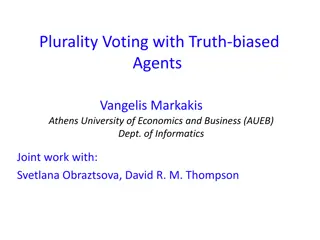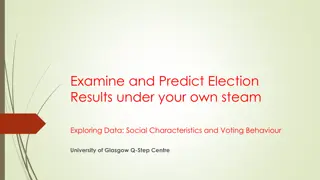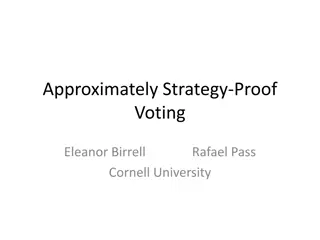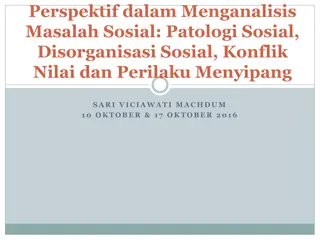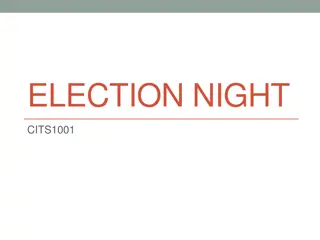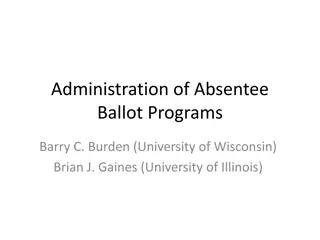Understanding Social Choice Theory and Voting Models
Explore the realm of Social Choice Theory and Voting Models, delving into mathematical theories that deal with aggregating individual preferences. Learn about the history, applications, and notable figures in this field, as well as various voting rules and algorithms used to determine winners based on voter rankings.
Download Presentation

Please find below an Image/Link to download the presentation.
The content on the website is provided AS IS for your information and personal use only. It may not be sold, licensed, or shared on other websites without obtaining consent from the author. Download presentation by click this link. If you encounter any issues during the download, it is possible that the publisher has removed the file from their server.
E N D
Presentation Transcript
Please form groups of 3-4 for todays lecture! Warm up: Design an algorithm to determine the winner of three candidates a, b, c given the ranking provided by ? individual voters, described by a 3 ? matrix ? function voting(?) Input: ? where ??? {a,b, c} is the candidate at rank ? for voter ? Output: ? {a, b, c} describes the winner Example Matrix ? a b c c b a b c a a b c Return ? 1
Announcement Assignments HW11 (online); Due 11/27 Wed, 10 pm HW12 (written) will be released soon; Due 12/4 Wed, 10 pm Due 12/6 Fri, 10 pm Due 12/2 Mon, 10 pm Piazza post for in-class questions 2
AI: Representation and Problem Solving Game Theory: Social Choice Instructors: Fei Fang & Pat Virtue Slide credits: CMU AI and http://ai.berkeley.edu
Learning Objectives Understand the voting model Find the winner under the following voting rules Plurality, Borda count, Plurality with runoff, Single Transferable Vote Describe the following concepts, axioms, and properties of voting rules Pairwise election, Condorcet winner Majority consistency, Condorcet consistency, Strategyproof Dictatorial, constant, onto Understand the possibility of satisfying multiple properties Describe the greedy algorithm for voting rule manipulation 4
Social Choice Theory A mathematical theory that deal with aggregation of individual preferences Wide applications in economics, public policy, etc. 20th Century Winners of Nobel Memorial Prize in Economic Sciences Amartya Kumar Sen Origins in Ancient Greece Kenneth Arrow 18th century Formal foundations by Condorcet and Borda 19th Century Charles Dodgson 5 Fei Fang 10/6/2024
Voting Model Model Set of voters ? = 1..? Set of alternatives ? ( ? = ?) Each voter has a ranking over the alternatives Preference profile: collection of all voters rankings Voter ID Ranking 1 a b c 2 c b a 3 b c a 4 a b c 6 Fei Fang 10/6/2024
Voting Rules Voting rule: function that maps preference profiles to alternatives that specifies the winner of the election function voting(?) Input: ? where ??? {a, b, c} is the candidate at rank ? for voter ? Output: ? {a, b, c} describes the winner Example Matrix ? a b c c b a b c a a b c Return ? 7 Fei Fang 10/6/2024
Voting Rules Plurality (used in almost all political elections) Each voter give one point to top alternative Alternative with most points win Who s the winner? a Voter ID Ranking 1 a b c 2 c b a 3 b c a 4 a b c 8 Fei Fang 10/6/2024
Voting Rules Borda count (used for national election in Slovenia) Each voter awards ? ? points to alternative ranked ?? Alternative with most points win Who s the winner? b Voter ID Ranking 1 a b c 2 c b a 3 b c a 4 a b c 9 Fei Fang 10/6/2024
Pairwise Election Alternative ?beats ? in pairwise election if majority of voters prefer ? to ? Who beats who in pairwise election? b beats c Voter ID Ranking 1 a b c 2 c b a 3 b c a 4 a b c
Voting Rules Plurality with runoff First round: two alternatives with highest plurality scores survive Second round: pairwise election between the two ? beats ? if majority of voters prefer ? to ? Who s the winner? Voter ID Ranking 1 a b c 2 c b a 3 b c a 4 a b c 12 Fei Fang 10/6/2024
Voting Rules Single Transferable Vote (STV) (used in Ireland, Australia, New Zealand, Maine, San Francisco, Cambridge) ? 1 rounds: In each round, alternative with least plurality votes is eliminated Alternative left is the winner Who s the winner? Voter ID Ranking 1 a b c 2 c b a 3 b c a 4 a b c 14 Fei Fang 10/6/2024
Tie Breaking Commonly used tie breaking rules include Borda count Having the most votes in the first round 16
Lets vote for candies! On your own, rank your favorite candies M&Ms Snickers Milky Way Kit Kat Skittles Compute the Plurality, Borda, STV winners in your group (you may need to choose a tie-breaking rule) 17
Representation of Preference Profile Identity of voters does not matter Only record how many voters has a preference 22 voters M&Ms Snickers Milky Way Kit Kat Skittles 30 voters Milky Way M&Ms Kit Kat Skittles Snickers 42 voter Kit Kat M&Ms Skittles Snickers Milky Way 18 Fei Fang 10/6/2024
Social Choice Axioms How do we choose among different voting rules? What are the desirable properties? 19 Fei Fang 10/6/2024
Majority consistency Majority consistency: Given a voting rule that satisfies Majority Consistency, if a majority of voters rank alternative ? first, then ? should be the final winner. 20 Fei Fang 10/6/2024
Piazza Poll 1 Which rules are not majority consistent? A: Plurality: Each voter give one point to top alternative B: Borda count: Each voter awards ? ? points to alternative ranked ?? C: Plurality with runoff: Pairwise election between two alternatives with highest plurality scores D: STV: In each round, alternative with least plurality votes is eliminated E: None F: I don t know 21 Fei Fang 10/6/2024
Condorcet Consistency Recall: ? beats ? in a pairwise election if majority of voters prefer ? to ? Condorcet winner is the alternative that beats every other alternative in pairwise election Does a Condorcet winner always exist? Condorcet paradox = cycle in majority preferences Voter ID Ranking over alternatives (first row is the most preferred) 1 a b c 2 c a b 3 b c a 23 Fei Fang 10/6/2024
Condorcet Consistency Condorcet consistency: A voting rule satisfies majority consistency should select a Condorcet Winner as the final winner if one exists. Which of the introduced voting rules (Plurality, Borda count, Plurality with runoff, STV) are Condorcet consistent? 24 Fei Fang 10/6/2024
Condorcet Consistency Winner under different voting rules in this example 33 voters 16 voters 3 voter 8 voters 18 voters 22 voters a b c d e b d c e a c d b a e c e b d a d e c b a e c b d a 25 Fei Fang 10/6/2024
Condorcet Consistency Winner under different voting rules in this example Plurality: a; Borda: b; STV: d; Plurality with runoff: e Condorcet winner: c 33 voters 16 voters 3 voter 8 voters 18 voters 22 voters a b c d e b d c e a c d b a e c e b d a d e c b a e c b d a 26 Fei Fang 10/6/2024
Strategy-Proofness Using Borda Count Who is the winner? Voter ID Ranking over alternatives (first row is the most preferred) 1 b a c d 2 b a c d 3 a b c d ? ? 3 2 1 0 Who is the winner now? Voter ID Ranking over alternatives (first row is the most preferred) 1 b a c d 2 b a c d 3 a c d b ? ? 3 2 1 0 27 Fei Fang 10/6/2024
Strategy-Proofness A single voter can manipulate the outcome! Voter ID Ranking over alternatives (first row is the most preferred) 1 b a c d 2 b a c d 3 a b c d ? ? 3 2 1 0 b: 2*3+1*2=8 a: 2*2+1*3=7 b is the winner Voter ID Ranking over alternatives (first row is the most preferred) 1 b a c d 2 b a c d 3 a c d b ? ? 3 2 1 0 b: 2*3+1*0=6 a: 2*2+1*3=7 a is the winner 29 Fei Fang 10/6/2024
Strategy-Proofness A voting rule is strategyproof (SP) if a voter can never benefit from lying about his preferences (regardless of what other voters do) Benefit: a more preferred alternative is selected as winner Do not lie: b is the winner Lie: a is the winner Voter ID 1 Ranking 2 b a c d 3 a b c d Voter ID 1 Ranking 2 b a c d 3 a c d b b a c d b a c d If a voter s preference is a>b>c, c will be selected w/o lying, and b will be selected w/ lying, then the voter still benefits 30 Fei Fang 10/6/2024
Piazza Poll 2 Which of the introduced voting rules are strategyproof? A: Plurality: Each voter give one point to top alternative B: Borda count: Each voter awards ? ? points to alternative ranked ?? C: Plurality with runoff: Pairwise election between two alternatives with highest plurality scores D: STV: In each round, alternative with least plurality votes is eliminated E: None F: I don t know 31 Fei Fang 10/6/2024
Greedy Algorithm for ? Manipulation Given voting rule ? and preference profile of ? 1 voters, how can the last voter report preference to let a specific alternative ?uniquely win (no tie breaking)? Greedy algorithm for ? Manipulation Rank ? in the first place While there are unranked alternatives If ? that can be placed in the next spot without preventing ? from winning place this alternative in the next spot else return false return true (with final ranking) Correctness proved (Bartholdi et al., 1989) 33 Fei Fang 10/6/2024
Greedy Algorithm for ? Manipulation Example with Borda count voting rule Voter ID Ranking over alternatives (first row is the most preferred) 1 b a c d 2 b a c d 3 a 34 Fei Fang 10/6/2024
Other Properties A voting rule is dictatorial if there is a voter who always gets his most preferred alternative A voting rule is constant if the same alternative is always chosen (regardless of the stated preferences) A voting rule is onto if any alternative can win, for some set of stated preferences Which of the introduced voting rules (Plurality, Borda count, Plurality with runoff, STV) are dictatorial, constant or onto? 36 Fei Fang 10/6/2024
Results in Social Choice Theory Why? Constant functions and dictatorships are SP Theorem (Gibbard-Satterthwaite): If ? 3, then any voting rule that is SP and onto is dictatorial Any voting rule that is onto and nondictatorial is manipulable It is impossible to have a voting rule that is strategyproof, onto, and nondictatorial 37 Fei Fang 10/6/2024
(Optional) Mechanism Design Overview and Second Price Auction 38
Lets have an auction! 1 box of milk chocolate to be purchased Each participant submit a bid (a number 0) I will give the chocolate to the one with the highest bid The person who get the chocolate needs to pay a price that equals the second highest bid provided by any participant (in dollars) How much will you bid? 39 Fei Fang 10/6/2024
Mechanism Design Mechanism specifies what actions the agent can take, and what is the outcome after the agents take actions Given a mechanism, the interaction among agents can be seen as a ?-player game Mechanism design: Choose a mechanism that can will cause rational agents to behave in a desired way, i.e., the solution or equilibrium of the induced game satisfy properties or optimize certain goals 40 Fei Fang 10/6/2024
Bayesian Game A player s utility function depends on his type In chocolate auction, a person on diet may have different valuation of the chocolate from a person who loves chocolate and is not on diet, leading to different utility functions Each participant knows his own type but only knows a prior distribution of other players type Keep in mind that once the auction mechanism is specified, it is a game among participating agents 41 Fei Fang 10/6/2024
Truthfulness A mechanism is truthful if each agent ? s equilibrium strategy is to report his true valuation (or utility function) Just a different name of strategyproofness in the context of mechanism design 42 Fei Fang 10/6/2024
Second Price Auction Every participant submitting a bid that equals their true valuation is a (Weakly) Dominant Strategy Equilibrium v or b 8 If ??< ?? If ?? ?? ?2 6 If ?1< ?2 If ?1> ?2 If ?1= ?1 (< ?2) If ?1< ?2 If ?1 ?2 If ?1= ?1 ( ?2) ?3 4 ?1 2 0 Player 1 Player 2 Player 3 43 Fei Fang 10/6/2024



